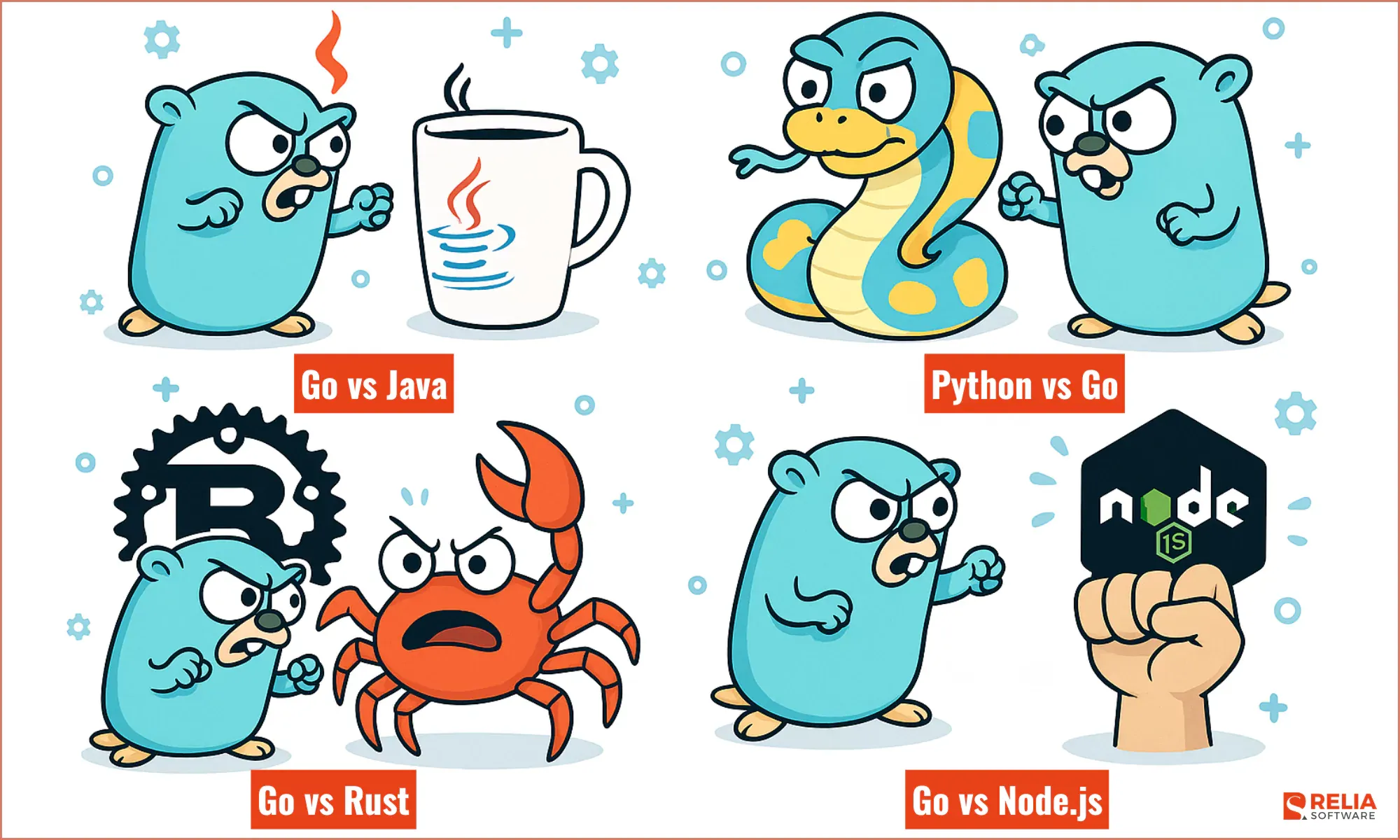Go, known as Golang, has became a strong programming language in recent years and attracted the interest of top corporations worldwide. Designed by Google in 2007 and released in 2009, Golang is today among the most popular programming languages for web development.
Go creates dependable and scalable web applications by combining simplicity, effectiveness, and high performance. You will discover its useful applications, and the reasons for the creation of so many well-known IT products in this article. We'll demonstrate this language's potential, contrast it with others, and share our relevant expertise.
>> Read more:
- How to Choose the Best Web Development Company?
- Gin-Gonic Tutorial: API Development in Go Using Gin-Gonic
Why Use Go for Web Development?
High Performance and Scalability
Go is a popular choice for web development by leading corporations because of its speed and scalability. Plus, Go is designed to use resources efficiently, so it can complete a lot of tasks fast without becoming slow.
Go's strong concurrency support and lightweight goroutines help developers manage a high volume of requests more easily without harming performance. So, for companies that need to process real-time data efficiently or deal with high traffic, this is a major benefit.
Simplified Development Process
Go maintains simplicity. Its simple, easy-to-learn syntax and minimalistic style enable developers to work more quickly and produce easily maintained code.
Additionally, it has a strong standard library that includes all the features you need including file processing, networking, encryption, and more. You thus do not have to depend much on third-party packages. Go is well-documented and easy to understand, hence developers may quickly prototype concepts, iterate fast, and speed up the development cycle.
Robust and Resilient Applications
Go’s focus on simplicity and reliability translates into robust web applications. Its strict compiler tests, built-in testing tools, and static typing help to early error detection thereby enhancing the stability of your code.
Go’s error-handling mechanism also motivates developers to often thoroughly look for errors, hence strengthening the resilience of their applications. Its built-in concurrency also makes it ideal for creating systems that remain operational even in the busiest of times.
>> Read more: Mastering 6 Golang Concurrency Patterns
Extensive Ecosystem and Tooling
Go provides many useful libraries, frameworks and tools along with a growing community. That Go community has developed many good Go packages to meet shared web development difficulties or anything you need like routing, databases, JWT authentication, or more.
Popular Golang frameworks like Gin, Echo, and Revel simplify and speed the creation of web apps. Go also fits many of the current systems, hence businesses may fit it into their present configurations without large overhauls.

>> Read more:
- Comprehending Arrays and Slices in Go Programming Language
- Practical Guide to Dependency Injection in Go
- The 10 Best IDEs for GoLang Web Development
Scalable Microservices Architecture
Go’s simplicity, performance, and built-in concurrency features make it an excellent choice for developing microservices architectures. Its small file sizes, quick start times, and efficient memory usage let teams build lightweight services that can handle loads of traffic.
Because Go works so well with container tools like Docker, it's easy to package, deploy, and scale microservices as needed. That’s why many companies choose Go when using microservices to boost their scalability and flexibility.
Efficient DevOps Practices
DevOps is another Go strength. Teams can provide updates more quickly thanks to its rapid performance and quick compile times.
Go's cross-platform support ensures seamless deployment. As Go generates self-contained binaries, you don't have to worry much about system compatibility issues. Because of all of this, Go is a fantastic option for teams that prioritize rapid deployment, continuous integration, and agile development.
>> Read more:
- Top Agile Frameworks In Software Engineering
- DevSecOps: Integrating Security into DevOps for Enhanced Software Development
When Go is The Best Match: Learning From the Experience of Top Companies
PayPal
Deployed Go to modernize and boost developers’ productivity.
The company was growing larger, so its platform needed to be simplified. As the company’s goal was to make transactions between billions of people worldwide quick and easy, C++, which they used before Go, couldn’t be a suitable solution to continue.
They needed something less complicated. Golang became a good support for PayPal as it offers simplicity and allows programs to write clear and easy-to-scale code. Besides, running the Go code resulted in a CPU reduction of 10%.
For 6 months, the developers had been working with Go, and as a result, presented its benefits for the company. They preferred the language for:
- Its fast tools,
- Rich libraries list,
- Type safety,
- An ability to compile machine code quickly,
- A convenient garbage collection.
And that’s not all. With the language, developers have had more time to think strategically instead of endlessly correcting code as compared to C++ or Java. It allowed the company to optimize development time without harming results. Now PayPal builds, tests, and releases pipelines with Go.
Bitly
Switched from Python to Go.
The company used Python language for most back-end services, and when they needed better performance, they turned to C. It was an appropriate solution, but the code maintainability had something to be desired with C. There are few C developers, and if something goes wrong, companies cannot guarantee that they will quickly find a programmer to help.
Bitly was searching for a simple language that could deliver a high performance. They wanted to find a language that would combine the advantages of Python and C. And Golang became this language. Since Bitly started to use it in their project (NSQ), the team has noticed that:
- The same workload can be run on fewer servers;
- Response time became nearly two times faster, as compared to Python;
- It took far less time to copy files to Google Storage;
- CPU load reduced.
The Bitly team liked that programmers could be onboarded in Go web development for a few weeks and start working on real tasks. No less important is that the Go community is welcoming and always ready to support, and the Bitly team appreciates it. Every year they participate in Gophercon, a conference for developers.
American Express
Made payments and rewards faster.
The company used at least three tools: С++, Java, and Node.js. They decided to try a new one to make payment processing faster, considering the high transaction volumes. Besides, they had two more goals: to modernize the architecture and build efficient apps for payment processing.
American Express chose Golang for:
- Speed;
- Scalability;
- Security;
- Code simplicity;
- Easily running code writing process;
- Contemporary tools and features;
- Great results in payments as well as rewards networks.
How did it happen that American Express chose this language?
The company’s developers knew about its benefits, and it was their idea to pilot the language. But before the company began applying it, the developers had organized a programming languages showdown to find out which was the best for their needs in performance and design.
They compared Go to С++, Java, and Node.js. It had a second result in performance (140,000 requests per second), but its tools, profiling and benchmarking features appeared to be impressive for the team.
After the showdown, American Express chose Golang also for high-performance microservices development. They didn’t originally plan to choose it for this purpose, but all the possibilities of the language, which the team noticed in practice, influenced their choice.
>> Read more:
- Cloud Success Blueprint: Why Go Is A Perfect Match?
- Type Conversion in Golang: How To Convert Data Types in Go?
Go vs. Other Web Development Languages
But is Golang better for web development than programming languages that existed and were successfully used before it? Let’s find out.
Go vs. Java
Java is a very good solution for large web apps and high loads, but Golang is becoming increasingly convenient for programmers due to its simplicity.
Go’s main advantages over Java are:
- Higher performance out of the box,
- Memory saving,
- Goroutines, which are cheaper than threads,
- CSP model,
- Better dependency management which is useful when you have a set of projects that inherits a common parent,
- Easy code that allows speed up the development.
Java’s advantages are:
- Rich language facilities that make it easier to write large monolithic projects,
- More garbage collectors for various situations,
- Lower cost of development.
Wrapping it up, both languages offer many tools and features. Which of them to choose depends on a specific task. In any case, Java developers can quickly study Go due to its simplicity—and start writing efficient code if necessary.
Go vs. Python
Python and Go have many benefits. Both are used for back-end, web and API development. But since Golang appeared, Python developers have mastered it and have yet to use their previous programming language.
Go’s main advantages over Python are:
- Faster execution,
- Better bugs detection,
- A big choice of libraries and plugins,
- Many special libraries for AI-powered apps,
- Error handling makes code more clear and stable,
- The code is easy to read,
- Easier syntax,
- Better concurrency,
- Saves CPU and memory resources more efficiently.
Python’s advantages are:
- Faster API development,
- Lower cost of development.
Sometimes Python can be used with Go in web development to achieve better results. It’s important to choose an experienced developer who knows in which cases to use one or both languages. If you are looking for such a specialist and want to learn how to do it, learn more about Golang outsourcing services.
>> Read more about Python:
- Why Should You Focus On Python For Machine Learning?
- Python Developer Salary Worldwide
- Top 10+ Best Python Development Companies In Australia
- Top Python Frameworks for Website Development
Go vs Rust
Rust and Golang have many benefits and similar features: they are often chosen for their performance, scalability, great range of tools, concurrence, and high speed. But they have some differences as well.
Go’s main advantages over Rust are:
- Easy to master and apply,
- Many libraries and frameworks,
- Simple syntax,
- Goroutines, which are cheaper than threads,
- It suits to handle large amounts of independent requests and is a perfect solution for server-side applications,
- Fast iteration and flexibility, so apps are easy to adopt and change for users’ needs,
- A few days are enough to onboard a programmer in a project,
- Lower cost of development.
Rust’s advantages are:
- Suits not only for web but for front-end and game development,
- Amount of control you have over memory management,
- Higher memory safety in complex systems,
- The best choice for low-level operations due to its finer control,
- Great at managing machine resources.
To sum up, we see that Rust and Golang can be used even in the most difficult and large-scale projects. They are worthy competitors which can give impressive results while used separately or together.
Go vs. Node.js
Many developers call Golang a “killer” of Node.js. Let’s see whether it is true. Go suits web development (especially large-scale back end), intensive data processing, real-time projects, and many other things. It’s a full-fledged language, while Node.js is a back-end JS runtime environment good for video games, messengers, and real-time apps.
Go’s main advantages over Node.js are:
- Scalability
- Stronger concurrency
- Being faster
- Flexibility
- Takes less time, memory, and CPU load to perform operations
- Good memory management capabilities
- Lower benchmark time which helps to find out how to improve performance in a program or set of programs
- More quality tools, especially for the back end
Node.js’ advantages are:
- Error handling is more convenient for most programmers,
- Easier to learn, especially for JS developers,
- More various tools, including front-end,
- Lower cost of development.
Due to Golang’s multiple benefits for large projects, it is a better choice than Node.js. But if you need something not that complicated—for example, a project you aren’t planning for long-term future growth—there is no point in a more expensive tool.

>> Read more about Node.js:
- Top 10 Best Node.Js Frameworks For Web Application
- How to Choose the Right NodeJS Development Company?
To Sum Things Up
- Go can be used for web development, API, charts, real-time communications, server apps, cloud-based services, cloud computing etc… Still, you’d better look for alternatives for mobile apps, graphics and front-end development.
- The Go programming language is often chosen for its simplicity and ability to save development resources and deliver great results.
- When compared to other languages and tools, this one, in many ways, surpasses Java, Python, Rust, and Node.js when you need to develop high-load or distributed systems.
- Major market players successfully use the language: for example, PayPal, Bitly, Dropbox, Netflix, and American Express.
At Relia Software, we have been developing back-end and high-load services for over 10+ years. Companies choose us for a client-oriented approach and our unique cross-industrial experience at what we do. Based on the strong engineering culture, our in-house team has created many projects we’re really proud of.
>>> Follow and Contact Relia Software for more information!
- Mobile App Development
- Web application Development
- development

